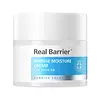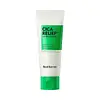What's inside
What's inside
 Key Ingredients
Key Ingredients

 Benefits
Benefits

 Concerns
Concerns

 Ingredients Side-by-side
Ingredients Side-by-side

Water
Skin ConditioningMethylpropanediol
SolventPanthenol
Skin ConditioningCyclopentasiloxane
EmollientCaprylic/Capric Triglyceride
MaskingMyristoyl/Palmitoyl Oxostearamide/Arachamide Mea
Skin ConditioningSorbitan Stearate
EmulsifyingHydroxyethyl Urea
HumectantSqualane
EmollientCetearyl Alcohol
EmollientGlyceryl Stearate Citrate
Emollient1,2-Hexanediol
Skin ConditioningGlycerin
HumectantCanola Oil
EmollientSodium Acrylic Acid/Ma Copolymer
Caprylyl Glycol
EmollientArginine
MaskingCarbomer
Emulsion StabilisingAllantoin
Skin ConditioningTocopherol
AntioxidantButylene Glycol
HumectantXanthan Gum
EmulsifyingViscum Album Fruit Extract
SoothingDihydroxyisopropyl Palmoylpalmamide
HumectantPhytosterols
Skin ConditioningRicinus Communis Seed Oil
MaskingEctoin
Skin ConditioningPropanediol
SolventSodium Hyaluronate
HumectantSodium Hyaluronate Crosspolymer
HumectantHydrolyzed Glycosaminoglycans
HumectantJuniperus Virginiana Oil
MaskingRosmarinus Officinalis Leaf Oil
MaskingCeramide NP
Skin ConditioningMadecassoside
AntioxidantCopaifera Officinalis Resin
MaskingHydrolyzed Hyaluronic Acid
HumectantBenzyl Glycol
SolventEucalyptus Globulus Leaf Oil
PerfumingHydroxypropyltrimonium Hyaluronate
Pogostemon Cablin Leaf Oil
MaskingLinoleic Acid
CleansingBeta-Glucan
Skin ConditioningSodium Acetylated Hyaluronate
HumectantViola Odorata Leaf Extract
MaskingLavandula Angustifolia Oil
MaskingCananga Odorata Flower Oil
MaskingArtemisia Vulgaris Oil
PerfumingAnthemis Nobilis Flower Oil
MaskingEthylhexylglycerin
Skin ConditioningJasminum Officinale Oil
MaskingFerula Galbaniflua Resin Oil
AntimicrobialChamomilla Recutita Flower Oil
MaskingHyaluronic Acid
HumectantRaspberry Ketone
MaskingWater, Methylpropanediol, Panthenol, Cyclopentasiloxane, Caprylic/Capric Triglyceride, Myristoyl/Palmitoyl Oxostearamide/Arachamide Mea, Sorbitan Stearate, Hydroxyethyl Urea, Squalane, Cetearyl Alcohol, Glyceryl Stearate Citrate, 1,2-Hexanediol, Glycerin, Canola Oil, Sodium Acrylic Acid/Ma Copolymer, Caprylyl Glycol, Arginine, Carbomer, Allantoin, Tocopherol, Butylene Glycol, Xanthan Gum, Viscum Album Fruit Extract, Dihydroxyisopropyl Palmoylpalmamide, Phytosterols, Ricinus Communis Seed Oil, Ectoin, Propanediol, Sodium Hyaluronate, Sodium Hyaluronate Crosspolymer, Hydrolyzed Glycosaminoglycans, Juniperus Virginiana Oil, Rosmarinus Officinalis Leaf Oil, Ceramide NP, Madecassoside, Copaifera Officinalis Resin, Hydrolyzed Hyaluronic Acid, Benzyl Glycol, Eucalyptus Globulus Leaf Oil, Hydroxypropyltrimonium Hyaluronate, Pogostemon Cablin Leaf Oil, Linoleic Acid, Beta-Glucan, Sodium Acetylated Hyaluronate, Viola Odorata Leaf Extract, Lavandula Angustifolia Oil, Cananga Odorata Flower Oil, Artemisia Vulgaris Oil, Anthemis Nobilis Flower Oil, Ethylhexylglycerin, Jasminum Officinale Oil, Ferula Galbaniflua Resin Oil, Chamomilla Recutita Flower Oil, Hyaluronic Acid, Raspberry Ketone
Water
Skin ConditioningPropanediol
SolventNiacinamide
SmoothingPanthenol
Skin ConditioningCetearyl Alcohol
EmollientButylene Glycol
Humectant1,2-Hexanediol
Skin ConditioningSqualane
EmollientTriethyl Citrate
MaskingCetyl Ethylhexanoate
EmollientCentella Asiatica Extract
CleansingAsiaticoside
AntioxidantAsiatic Acid
Skin ConditioningMadecassic Acid
Skin ConditioningGlyceryl Stearate Citrate
EmollientGlyceryl Stearate
EmollientDiisostearyl Malate
EmollientHydroxyethyl Acrylate/Sodium Acryloyldimethyl Taurate Copolymer
Emulsion StabilisingAcrylates/C10-30 Alkyl Acrylate Crosspolymer
Emulsion StabilisingTromethamine
BufferingHydroxyacetophenone
AntioxidantLecithin
EmollientDisodium EDTA
Adenosine
Skin ConditioningSorbitan Isostearate
EmulsifyingMelia Azadirachta Leaf Extract
Skin ConditioningMelia Azadirachta Flower Extract
Skin ConditioningDipotassium Glycyrrhizate
HumectantMyristoyl/Palmitoyl Oxostearamide/Arachamide Mea
Skin ConditioningArginine
MaskingWater, Propanediol, Niacinamide, Panthenol, Cetearyl Alcohol, Butylene Glycol, 1,2-Hexanediol, Squalane, Triethyl Citrate, Cetyl Ethylhexanoate, Centella Asiatica Extract, Asiaticoside, Asiatic Acid, Madecassic Acid, Glyceryl Stearate Citrate, Glyceryl Stearate, Diisostearyl Malate, Hydroxyethyl Acrylate/Sodium Acryloyldimethyl Taurate Copolymer, Acrylates/C10-30 Alkyl Acrylate Crosspolymer, Tromethamine, Hydroxyacetophenone, Lecithin, Disodium EDTA, Adenosine, Sorbitan Isostearate, Melia Azadirachta Leaf Extract, Melia Azadirachta Flower Extract, Dipotassium Glycyrrhizate, Myristoyl/Palmitoyl Oxostearamide/Arachamide Mea, Arginine
 Reviews
Reviews

Ingredients Explained
These ingredients are found in both products.
Ingredients higher up in an ingredient list are typically present in a larger amount.
1,2-Hexanediol is a synthetic liquid and another multi-functional powerhouse.
It is a:
- Humectant, drawing moisture into the skin
- Emollient, helping to soften skin
- Solvent, dispersing and stabilizing formulas
- Preservative booster, enhancing the antimicrobial activity of other preservatives
Arginine is an amino acid that is important for human development. Your body uses is it to produce hair keratin and skin collagen.
As a cosmetic ingredient, Arginine has antioxidant properties and can also help repair damaged skin. This ingredient is derived either synthetically or from animals.
Arginine isn't fungal acne safe when used in the presence of other lipids (fats, fatty acids, oils, esters, etc). Oils and fats occur naturally within the skin, so take caution when using Arginine if you're prone to fungal acne.
Learn more about ArginineButylene Glycol (or BG) is used within cosmetic products for a few different reasons:
Overall, Butylene Glycol is a safe and well-rounded ingredient that works well with other ingredients.
Though this ingredient works well with most skin types, some people with sensitive skin may experience a reaction such as allergic rashes, closed comedones, or itchiness.
Learn more about Butylene GlycolCetearyl alcohol is a mixture of two fatty alcohols: cetyl alcohol and stearyl alcohol. It is mainly used as an emulsifier. Emulsifiers help prevent the separation of oils and products. Due to its composition, it can also be used to thicken a product or help create foam.
Cetearyl alcohol is an emollient. Emollients help soothe and hydrate the skin by trapping moisture.
Studies show Cetearyl alcohol is non-toxic and non-irritating. The FDA allows products labeled "alcohol-free" to have fatty alcohols.
This ingredient is usually derived from plant oils such as palm, vegetable, or coconut oils. There is debate on whether this ingredient will cause acne.
Due to the fatty acid base, this ingredient may not be Malassezia folliculitis safe.
Learn more about Cetearyl AlcoholGlyceryl Stearate Citrate is a citric acid ester of glyceryl stearate.
It is an emulsifier, emollient, and a surfactant.
Emulsifiers help stabilize a product. It does this by preventing certain ingredients from separating. Common ingredients include oils and water, which do not mix naturally. Emulsifiers have properties that help keep ingredients such as these together.
Emollients help soothe and soften the skin. They do this by creating a protective film on your skin. This barrier helps trap moisture and keeps your skin hydrated. Emollients may be effective at treating dry or itchy skin.
Surfactants help gather oils, dirt, and other pollutants from the skin. This helps them to be easily rinsed away.
Learn more about Glyceryl Stearate CitrateWe don't have a description for Myristoyl/Palmitoyl Oxostearamide/Arachamide Mea yet.
Panthenol is a common ingredient that helps hydrate and soothe the skin. It is found naturally in our skin and hair.
There are two forms of panthenol: D and L.
D-panthenol is also known as dexpanthenol. Most cosmetics use dexpanthenol or a mixture of D and L-panthenol.
Panthenol is famous due to its ability to go deeper into the skin's layers. Using this ingredient has numerous pros (and no cons):
Like hyaluronic acid, panthenol is a humectant. Humectants are able to bind and hold large amounts of water to keep skin hydrated.
This ingredient works well for wound healing. It works by increasing tissue in the wound and helps close open wounds.
Once oxidized, panthenol converts to pantothenic acid. Panthothenic acid is found in all living cells.
This ingredient is also referred to as pro-vitamin B5.
Learn more about PanthenolPropanediol is an all-star ingredient. It softens, hydrates, and smooths the skin.
It’s often used to:
Propanediol is not likely to cause sensitivity and considered safe to use. It is derived from corn or petroleum with a clear color and no scent.
Learn more about PropanediolSqualane is an emollient that helps the skin hold onto moisture. It's an oily liquid that occurs naturally in certain types of fish and plant oils.
Because squalane boosts hydration in the skin, it also comes with plenty of benefits: it is an antioxidant and can help fight free radicals and skin damage. Squalane is also found to have a detoxifying effect when applied.
Squalane comes from squalene, which occurs naturally within the sebum of our skin. It is one of the oils our skin produces to keep itself hydrated. Squalane is the hydrogenated version of squalene and has a longer shelf life.
Research shows that squalane is non-irritating (even at 100% concentration).
In general, it's a fantastic ingredient. It does a great job at hydrating the skin, and it's suitable for those with sensitive skin.
The source of squalane may impact malassezia / fungal acne. This is because olive oil derived squalane can contain impurities such as fatty acids and plant waxes. Sugarcane derived squalane is recommended for anyone with malassezia concerns.
Is squalane vegan?
This depends on the source. Squalane can be derived from both plants and animals. Most squalane used in skincare comes from plants.
Please note: the source of squalane is only known if disclosed by the brand. We recommend reaching out to the brand if you have any questions about their squalane.
Read more about squalene with an "e".
Is squalane an oil?
Squalane is often called an oil, but it’s technically not; it’s a hydrocarbon, meaning it’s only made of carbon and hydrogen, unlike true oils which are triglycerides made of fatty acids and glycerol.
The term “oil-free” isn’t regulated, so companies can define it however they want. Some exclude all oils, while others just avoid mineral oil or comedogenic oils.
While some people avoid oils thinking they cause breakouts, the right kind of oil (or oil-like ingredient like squalane) can actually help balance and hydrate your skin. It’s worth testing out simple oils or squalane to see what works best for your skin.
Learn more about SqualaneWater. It's the most common cosmetic ingredient of all. You'll usually see it at the top of ingredient lists, meaning that it makes up the largest part of the product.
So why is it so popular? Water most often acts as a solvent - this means that it helps dissolve other ingredients into the formulation.
You'll also recognize water as that liquid we all need to stay alive. If you see this, drink a glass of water. Stay hydrated!
Learn more about Water